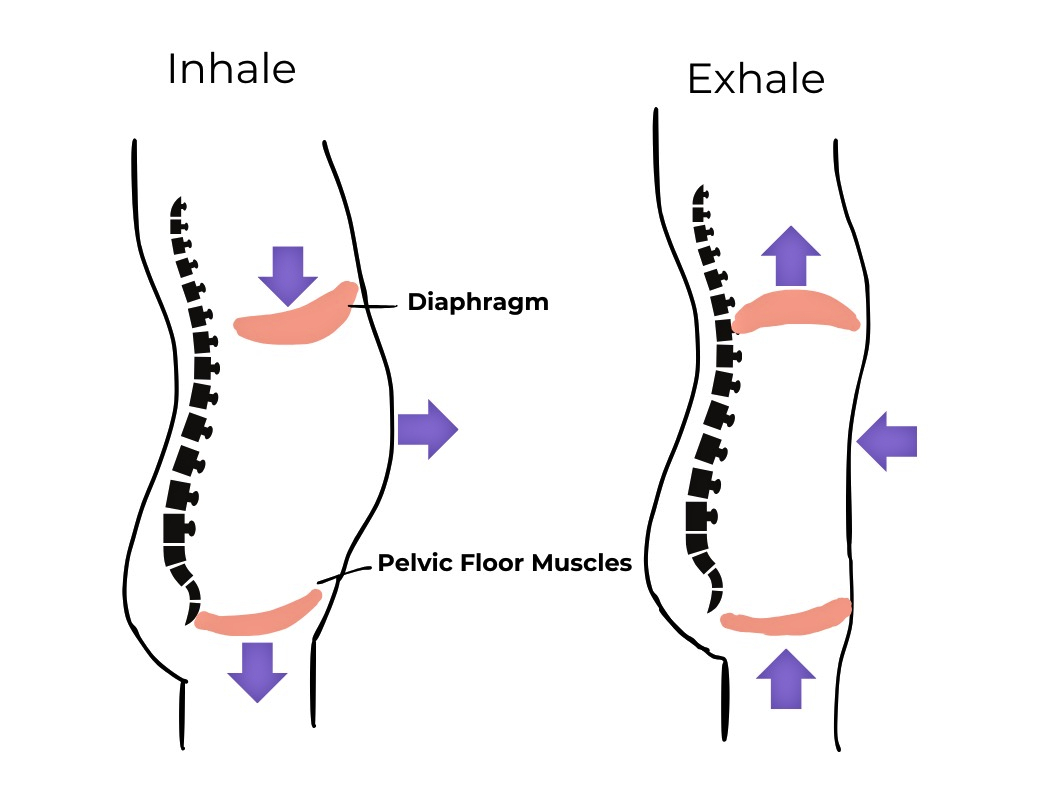Back
Exploring the Connection: Different Types of Breathing and the Pelvic Floor
By Shannon Strauch, PTA, STMT-1 on 3/8/2024

Introduction: Breathing is an essential physiological process that influences various aspects of our health and well-being. While we often think of breathing in terms of inhaling and exhaling air, there's much more complexity to it, including its impact on the pelvic floor. The pelvic floor, a group of muscles located at the base of the pelvis, plays a crucial role in supporting the bladder, bowel, and reproductive organs. In this blog post, we'll delve into the connection between different types of breathing and the pelvic floor, exploring how various breathing patterns can affect pelvic floor function and overall health.
Understanding the Pelvic Floor: Before delving into the relationship between breathing and the pelvic floor, it's important to understand the pelvic floor's role in the body. The pelvic floor consists of muscles, ligaments, and connective tissue that support the organs in the pelvis and contribute to bladder and bowel control. These muscles also play a role in sexual function and stability of the pelvis and spine.
Breathing and the Pelvic Floor: The way we breathe can impact the pelvic floor in several ways. Different breathing patterns engage different muscle groups, including those in the pelvic floor. Here are some examples of how various types of breathing affect the pelvic floor:
Diaphragmatic Breathing: Diaphragmatic breathing, also known as belly breathing, involves engaging the diaphragm to expand the lungs fully. This type of breathing can promote relaxation and proper alignment of the pelvic floor muscles. As the diaphragm descends during inhalation, it creates downward pressure on the pelvic floor, facilitating relaxation and optimal function.
Pelvic Floor Breathing: Pelvic floor breathing focuses on consciously engaging and relaxing the pelvic floor muscles with each breath. This technique helps improve awareness of the pelvic floor and can be beneficial for individuals with pelvic floor dysfunction, such as pelvic pain or urinary incontinence. It involves inhaling while gently contracting the pelvic floor muscles and exhaling while releasing the contraction.
Shallow Breathing: Shallow breathing, characterized by quick, shallow breaths primarily in the chest, can contribute to tension in the pelvic floor muscles. Chronic shallow breathing patterns may lead to increased muscle tension and pelvic floor dysfunction over time.
Breath Holding: Holding the breath, whether consciously or unconsciously, can create increased intra-abdominal pressure (Valsalva), which can strain the pelvic floor muscles. Individuals who frequently hold their breath during activities like lifting heavy objects or during exercise may be at risk of pelvic floor issues such as prolapse or urinary leakage.
Coordinated Breathing with Movement: Proper coordination of breathing with movement is essential for optimal pelvic floor function, especially during activities such as exercise or childbirth. Learning to synchronize breath with movement can help support the pelvic floor and reduce the risk of injury or dysfunction.
Paradoxical Breathing: Also known as paradoxical chest movement or paradoxical respiration, is a breathing pattern where the chest moves inward during inhalation and outward during exhalation, contrary to the normal breathing pattern where the chest expands during inhalation and contracts during exhalation. This can be due to diaphragmatic dysfunction, injury, nerve involvement, or lung issues such as COPD
Benefits of Breath Awareness and Training: Developing awareness of breathing patterns and practicing techniques to improve breathing can have significant benefits for pelvic floor health and overall well-being. Some potential benefits include:
Improved pelvic floor muscle function and coordination.
Reduced tension and pain in the pelvic region.
Enhanced relaxation and stress management.
Prevention of pelvic floor dysfunction and related issues.
Support during pregnancy, childbirth, and postpartum recovery.
Conclusion: Breathing plays a vital role in pelvic floor function and overall health. By understanding the connection between different types of breathing and the pelvic floor, individuals can incorporate mindful breathing practices into their daily lives to support pelvic floor health and promote well-being. Whether it's through diaphragmatic breathing, pelvic floor awareness, or coordinated breathing with movement, cultivating a mindful approach to breathing can have profound benefits for pelvic floor function and overall quality of life.
Read More:
How Chronic Pelvic Congestion in Men Contributes to Prostatitis By Shannon Strauch, PTA, STMT-1 on 12/11/2024 How lymphatic issues can cause symptoms of prostatitis Prostatitis and Tight Pelvic Floor Muscles: A Comprehensive Guide By Shannon Strauch, PTA, STMT-1 on 12/10/2024 How a tight pelvic floor can be the reason for prostatitis symptoms
Are you ready to live pain free?
Request An Appointment